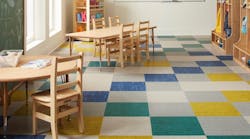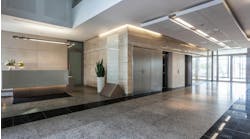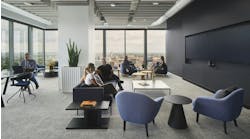We’ve all had the experience of entering a building and suddenly being lost.
Wayfinding is the use of signage, color and other design elements that helps one orient themselves and navigate within a physical space. The most optimal wayfinding is incorporated into the initial design of the building, but if your facility is already completed, there are easy ways to integrate it into an existing floor plan.
1. Lighting
Lighting is often considered one of the one-and-done aspects of design, particularly now that LEDs provide long-term solutions. Even if you’re using non-LED lighting, most systems are created to easily switch out the bulb rather than start from scratch.
However, if you’re looking to install new lighting or have the ability to change the placement of existing light fixtures, lighting can become one of the simplest ways to create subliminal wayfinding. (Pictured: RXR Realty used Juniper’s THIN Primaries around doorways and in a consecutive direction to point visitors on their way.)
For high-traffic areas, particularly where visitors are coming in and out of the space, lighting can be used to provide direction and symbolize stopping points in these two ways:
- Provide direction: Install tube lighting or tracks vertically along the main pathway. Lighting that runs in the same direction that one should move gives users something to follow without a blatant arrow pointing down the walkway.
- Symbolize stopping points: In video games, a computer-controlled person of interest is often lit from above or below. Similar tactics can be used in the real-life physical space as well. Reception desks can utilize lighting in different ways than the rest of the space. This can be done by installing LEDs under the counter’s visitor-facing surface, concentrating overhead lighting above the desk or back-lighting the counter through the use of lights placed on the wall behind the desk.
By hanging geometric lighting above a reception desk, waiting area or other points of interest, visitors are informed that this is a place they should be attracted to.
2. Flooring
Instead, modular carpet tiles provide not only unique design solutions, but a less costly option in flooring as individual pieces can be replaced when damaged and stained rather than the whole floor.
(Pictured: Flooring collections are designed to be mixed and matched to create wayfinding options. Drawn Lines by Interface, one of our Merit Prize winners from our Product Innovations 2018 contest, can be used to install a “Yellow ‘Brick’ Road” here.)
Because of the popularity of carpet tiles, flooring manufacturers are creating designs that can be used for wayfinding through installation direction, pattern, color and material:
Color: Similar to the new patterns found in flooring collections, many manufacturers are incorporating color as a wayfinding technique. Playing with gradient colors provides walkways. Think of it like the Yellow Brick Road, but with fewer unfulfilled, animated fellow travelers along the way (we’re assuming). (Pictured: Carpet tiles are frequently designed with gradients along the length for pattern and color-based wayfinding. Nutopia by Mohawk Group)
3. Color
Like we point out above, color can be a successful wayfinding technique in carpeting, but the same idea can be applied to walls, furniture, partitions and more. Color can also be the easiest method of wayfinding for existing spaces:
A few of the products highlighted in this article are also winners of our 2018 Product Innovations contest.
Check out these other innovative ideas for your facility!
4. Signage
Of course, the simplest way to create clear wayfinding is to make sure that signage is clear, legible and at appropriate intervals. If someone needs to guess whether their destination is just around the corner or on the other side of the building, it can cause frustration.
One thing of note: if your building is often host to people of varying languages, it’s important to include symbols where applicable.
Signage doesn’t need to be a hassle, either. There are plenty of companies out there that produce creative standardized signage packages, and vinyl sticker decals are perfect stick-and-go options that can be installed nearly instantly. And when all else fails, chalkboard sandwich boards are making a huge comeback in design.
Two hand-picked articles to read next:



